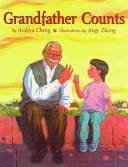
When Helen’s grandfather, Gong Gong, comes from China to live with her family, he’s shocked to find that none of his grandchildren speak Chinese. How will he communicate with them? At first he keeps to himself. Then one day he joins Helen to watch the trains. He starts counting the train cars in Chinese, and she repeats the words. Then Helen says the numbers in English. They continue to teach each other, and Helen even learns her Chinese name, which means “flower.” In this luminously illustrated intergenerational story, the devotion between a young girl and her grandfather helps them overcome barriers of age and language.
- ISBN: 9781584301585
- Published: 2003
- Themes: Asian American, Chinese, Family life, multicultural, multigenerational
- Descriptors: Picture Book, Primary (ages 6-9), United States
- No. of pages: 32

Grandfather’s Counts does not necessarily focus on the biracial identity of the Chinese-American protagonist, Helen. While many of biracial literature portray the theme of cultural identity such as fitting, acceptance, and confusion as the center of a story plot, this Grandfather’s Counts rather focuses on language and relationship for Helen’s identity than her being biracial. What is more interesting though in this story is that math plays another language arts.
Gong Gong is Helen’s mother’s dad. He joins Helen’s family from China. Gong Gong speaks no English but Chinese language. He reads newspaper in Chinese. Although Helen is inquisitive about him and wants to get to know her new grandfather better, language barrier makes things complicating for that. One day the grandfather joins Helen when she is sitting on the back wall. Together they count the train cars as the freight rumbles past. Slowly and magically Helen learns the primary eight numbers in Chinese and her grandfather also learns them in English. Their new relationship grows strong and comfortable even though oral communication is not yet fully ready.
It is significant to recognize that even though biracial aspect is an important experience in children’s books, identity is not influenced by just one thing like racial appearance but a wide range of elements that construct cultural “being”. This book shares that language, relationships, and common humanity are essential for explaining who Helen and Gong Gong are. In this book, I found Helen’s agency is enhanced through a new relationship and new language learning. Unfamiliar Chinese language is also part of Helen.